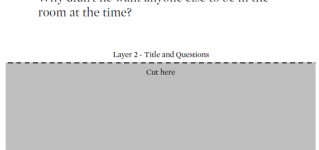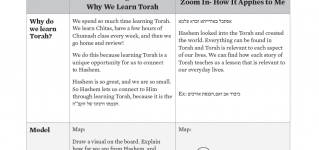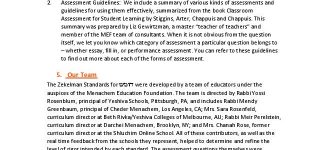The Nature and Purpose of תורה שבכתב
| Enduring Understandings |
|---|
| 1. Learning תורה is a unique opportunity to unite with ‘ה. |
| 2. תורה is eternal and unchanging. |
| 3. תורה is the only absolute truth. |
| 4. The language of חומש is לשון הקודש, the G-dly language with which ‘ה created the world. תורה is written very concisely, with every detail and juxtaposition of events/narratives/הלכות having untold and sacred significance. |
| 5. תורה is ‘ה’s infinite wisdom and can never be fully understood, while also allowing for multiple levels of understanding. (פרד”ס) |
| 6. תורה שבעל פה and תורה שבכתב are two parts of one whole, fully dependent on one another. |
| 7. ה’ gave us the rules and tools to learn the Torah; these are also part of Torah. (Upper grades) |
| 8. ה’ transmitted His whole תורה to us through משה רבינו, at הר סיני. |
| 9. As the blueprint of creation, תורה is relevant in all areas of life and everything in the world is contained within it. (אסתכל באורייתא… הפך בה והפך…) |
| 10. תורה is ה’ communicating to humans; guiding our lives and teaching us lessons. (It is not primarily a history book). |
| 11. When applying תורה to our personal lives, we should use the guidance of other תורה sources to be sure that we are taking a lesson that is in the spirit of what the תורה intends. |
| 12. What happened to our אבות is a precursor for what will happen to the Jewish people in the future, and gives us the כח to endure similar challenges. (מעשה אבות סימן לבנים – חומש בראשית) |
| Essential Questions |
|---|
| 1. Why spend so much time learning חומש? Why do we study what is no longer practiced? |
| 2. What is the relationship between תורה and science? What kinds of questions am I allowed to ask? |
| 3. What is the relationship between תורה and science? What kinds of questions am I allowed to ask? |
| 4. Are details important? Does sequence matter? |
| 5. Can questions have more than one answer? Is there more than one way to explain this? How can different opinions both be true? (Upper grades – what does חסידות add to our understanding?) |
| 6. How do we know that? [If I don’t see the information in the חומש,] Who said so? Where does it say that? Why didn’t the חומש say this explicitly? |
| 7. Can I make up my own interpretation? |
| 8. ה’ transmitted His whole תורה to us through משה רבינו, at הר סיני. |
| 9. What does the תורה say about this issue/topic? |
| 10. What does this teach me? How is this relevant to my own life? |
| 11. What does this teach me? How is this relevant to my own life? |
| 12. Why does the תורה record some events while leaving out others? Why are these stories so important? |
1.01 חכמתו ורצונו של הקב”ה
B. Relates to study of חומש with appropriate reverence, as reflected in conduct according to הלכה and דרך ארץ (such as washing נעגל וואסער and saying ברכות התורה before learning, and sitting respectfully).[1]
C. Knows that time spent learning תורה is an opportunity to fulfill the מצוה (and daily חיוב of לימוד תורה.)
D. Identifies the חומש texts as the identical text found in other printed חומשים or in a ספר תורה.
E. N/A
F. Knows that there is an orderly sequence to חומש that is usually chronological.
G. N/A
H. N/A
I. N/A
J. Knows that the תורה was given through משה רבינו at הר סיני.
K. N/A
B. Relates to study of חומש with appropriate reverence, as reflected in conduct according to הלכה and דרך ארץ (such as washing נעגל וואסער and saying ברכות התורה before learning, and sitting respectfully).
C. Knows that time spent learning תורה is an opportunity to fulfill the מצוה (and daily חיוב of לימוד תורה.)
D. Identifies the חומש texts as the identical text found in other printed חומשים or in a ספר תורה.
E. N/A
F. Knows that there is an orderly sequence to חומש that is usually chronological.
G. N/A
H. N/A
I. Recognizes that we need תורה שבעל פה (as cited by commentaries on חומש) to assist in understanding the פסוק.
J. Knows that the תורה was given through משה רבינו at הר סיני.
K. N/A
B. Relates to study of חומש with appropriate reverence, as reflected in conduct according to הלכה and דרך ארץ (such as washing נעגל וואסער and saying ברכות התורה before learning, and sitting respectfully).[1]
C. Describes the תורה as חכמתו ורצונו של הקב”ה, and Torah study as an opportunity to connect with ה‘ (as a “meeting of minds,” so to speak).
D. Knows that every ספר תורה has been copied from a pre-existing ספר תורה, all the way back to the first one that was written by משה רבינו in the מדבר. Therefore the text of all ספרי תורה throughout the world, and throughout the ages, is always the same.
E. Asks, “I don’t understand,” instead of “it doesn’t make sense.”
F. Knows that there is an orderly sequence to חומש that is usually chronological.
G. N/A
H. Recognizes the role of commentary in providing additional levels of understanding.
I. N/A
J. Recognizes that we need תורה שבעל פה (as cited by commentaries on חומש) to assist in understanding the פסוק.
K. Knows that תורה שבעל פה was given with the תורה שבכתב to משה רבינו at הר סיני.
L. N/A
B. Relates to study of חומש with appropriate reverence, as reflected in conduct according to הלכה and דרך ארץ (such as washing נעגל וואסער and saying ברכות התורה before learning, and sitting respectfully).[1]
C. Describes the תורה as חכמתו ורצונו של הקב”ה, and Torah study as an opportunity to connect with ה‘ (as a “meeting of minds,” so to speak).
D. Knows that every ספר תורה has been copied from a pre-existing ספר תורה, all the way back to the first one that was written by משה רבינו in the מדבר. Therefore the text of all ספרי תורה throughout the world, and throughout the ages, is always the same.
E. Asks, “I don’t understand,” instead of “it doesn’t make sense.”
F. Knows that there are sometimes deviations in the order of the חומש, to bring out other messages than chronology, and quotes the מחז”ל
“אין מוקדם ומאוחר בתורה”.
G. Knowns that פרשיות are placed in particular order for particular reasons and this juxtaposition is called הפרשיות סמיכות.
H. Recognizes the role of commentary in providing additional levels of understanding.
I. Differentiates between דרש and פשט.
J. Recognizes that we need תורה שבעל פה (as cited by commentaries on חומש) to assist in understanding the פסוק.
K. Knows that תורה שבעל פה was given with the תורה שבכתב to משה רבינו at הר סיני.
L. N/A
B. Relates to study of חומש with appropriate reverence, as reflected in conduct according to הלכה and דרך ארץ (such as washing נעגל וואסער and saying ברכות התורה before learning, and sitting respectfully).[1]
C. Describes the תורה as חכמתו ורצונו של הקב”ה, and Torah study as an opportunity to connect with ‘ה (as a “meeting of minds,” so to speak).
D. Knows that every ספר תורה has been copied from a pre-existing ספר תורה, all the way back to the first one that was written by משה רבינו in the מדבר. Therefore the text of all ספרי תורה throughout the world, and throughout the ages, is always the same.
E. Asks “how can we understand this better,” and looks for possible solutions, rather than disagreeing or making judgmental statements.
F. Knows that there are sometimes deviations in the order of the חומש, to bring out other messages than chronology, and quotes the מחז”ל
“אין מוקדם ומאוחר בתורה”.
G. Recognizes that there can be more than one understanding to explain the text, and quotes the [מחז”ל “שבעים פנים לתורה.”[3
H. Differentiates between דרש and פשט.
I. Recognizes that we need תורה שבעל פה (as cited by commentaries on חומש) to assist in understanding the פסוק.
J. Explains that תורה שבעל פה employs specific rules of interpretation, and cites and explains the examples of קל וחומר and גזירת שוה.
K. Quotes the מחז”ל, “הפך בה והפך בה דכולא בה,” and explains that, therefore, תורה has a say about any issue in our lives and in the world around us (citing examples from the text being learned[4]).
B. Relates to study of חומש with appropriate reverence, as reflected in conduct according to הלכה and דרך ארץ (such as washing נעגל וואסער and saying ברכות התורה before learning, and sitting respectfully).[1]
C. Describes the תורה as חכמתו ורצונו של הקב”ה, and Torah study as an opportunity to connect with ה‘ (as a “meeting of minds,” so to speak).
D. Knows that every ספר תורה has been copied from a pre-existing ספר תורה, all the way back to the first one that was written by משה רבינו in the מדבר. Therefore the text of all ספרי תורה throughout the world, and throughout the ages, is always the same.
E. Asks “how can we understand this better,” and looks for possible solutions, rather than disagreeing or making judgmental statements.
F. Knows that there are sometimes deviations in the order of the חומש, to bring out other messages than chronology, and quotes the מחז”ל
“אין מוקדם ומאוחר בתורה”.
G. Recognizes that there can be more than one understanding to explain the text, and quotes the מחז”ל “שבעים פנים לתורה.” [3]
H. Differentiates between דרש and פשט.
I. Recognizes that we need תורה שבעל פה (as cited by commentaries on חומש) to assist in understanding the פסוק.
J. Explains that תורה שבעל פה employs specific rules of interpretation, and cites and explains the examples of קל וחומר and גזירת שוה.
K. Quotes the מחז”ל, “הפך בה והפך בה דכולא בה,” and explains that, therefore, תורה has a say about any issue in our lives and in the world around us (citing examples from the text being learned[4]).
B. Relates to study of חומש with appropriate reverence, as reflected in conduct according to הלכה and דרך ארץ (such as washing נעגל וואסער and saying ברכות התורה before learning, and sitting respectfully).[1]
C. Explains that תורה study is an opportunity to achieve a singular unity with ה[2]
D. Explains the main ideas of the 8th and 9th principles of the רמב“ם’s י“ג עקרי אמונה concerning the Divine origin and unchanging nature of תורה.
E. Asks “how can we understand this better,” and looks for possible solutions, rather than disagreeing or making judgmental statements.
F. Knows that there are sometimes deviations in the order of the חומש, to bring out other messages than chronology, and quotes the מחז”ל
“אין מוקדם ומאוחר בתורה”.
G. Recognizes that there can be more than one understanding to explain the text, and quotes the מחז”ל “שבעים פנים לתורה.”[3]
H. Differentiates between פשט, רמז, דרש and סוד.
I. Recognizes that we need תורה שבעל פה (as cited by commentaries on חומש) to assist in understanding the פסוק.
J. Explains that תורה שבעל פה employs specific rules of interpretation, and cites and explains the examples of קל וחומר and גזירת שוה.
K. Quotes the מחז”ל, “הפך בה והפך בה דכולא בה,” and explains that, therefore, תורה has a say about any issue in our lives and in the world around us (citing examples from the text being learned[4]).
B. Relates to study of חומש with appropriate reverence, as reflected in conduct according to הלכה and דרך ארץ (such as washing נעגל וואסער and saying ברכות התורה before learning, and sitting respectfully).[1]
C. Explains that תורה study is an opportunity to achieve a singular unity with ה[2]
D. Explains the main ideas of the 8th and 9th principles of the רמב“ם’s י“ג עקרי אמונה concerning the Divine origin and unchanging nature of תורה.
E. Asks “how can we understand this better,” and looks for possible solutions, rather than disagreeing or making judgmental statements.
F. Knows that there are sometimes deviations in the order of the חומש, to bring out other messages than chronology, and quotes the מחז”ל
“אין מוקדם ומאוחר בתורה”.
G. Recognizes that there can be more than one understanding to explain the text, and quotes the מחז”ל “שבעים פנים לתורה.”[3]
H. Differentiates between פשט, רמז, דרש and סוד.
I. Recognizes that we need תורה שבעל פה (as cited by commentaries on חומש) to assist in understanding the פסוק.
J. Explains that תורה שבעל פה employs specific rules of interpretation, and cites and explains the examples of קל וחומר and גזירת שוה.
K. Quotes the מחז”ל, “הפך בה והפך בה דכולא בה,” and explains that, therefore, תורה has a say about any issue in our lives and in the world around us (citing examples from the text being learned[4]).
Grades 3-6: Describes the תורה as חכמתו ורצונו של הקב”ה, and Torah study as an opportunity to connect with ה‘ (as a “meeting of minds,” so to speak).
Grades 7-8: Explains that תורה study is an opportunity to achieve a singular unity with ה‘i[2].
Grades 3-6: Knows that every ספר תורה has been copied from a pre-existing ספר תורה, all the way back to the first one that was written by משה רבינו in the מדבר. Therefore the text of all ספרי תורה throughout the world, and throughout the ages, is always the same.
Grades 7-8:Explains the main ideas of the 8th and 9th principles of the רמב“ם’s י“ג עקרי אמונה concerning the Divine origin and unchanging nature of תורה.
Grades 3-4: Asks, “I don’t understand,” instead of “it doesn’t make sense.”
Grades 5-8: Asks “how can we understand this better,” and looks for possible solutions, rather than disagreeing or making judgmental statements.
Grades 4-8:
Knows that there are sometimes deviations in the order of the חומש, to bring out other messages than chronology, and quotes the מחז”ל “אין מוקדם ומאוחר בתורה”.
Grades 4-8: Knowns that פרשיות are placed in particular order for particular reasons and this juxtaposition is called הפרשיות סמיכות.
Grades 3-4: Recognizes the role of commentary in providing additional levels of understanding.
Grades 5-8: Recognizes that there can be more than one understanding to explain the text, and quotes the מחז”ל “שבעים פנים לתורה.”i[3]
Grades 4-6: Differentiates between דרש and פשט.
Grades 7-8: Differentiates between פשט, רמז, דרש and סוד.
Grades 2-8: Recognizes that we need תורה שבעל פה (as cited by commentaries on חומש) to assist in understanding the פסוק.
Grades 3-4: Knows that תורה שבעל פה was given with the תורה שבכתב to משה רבינו at הר סיני.
Grades 5-8: Explains that תורה שבעל פה employs specific rules of interpretation, and cites and explains the examples of קל וחומר and גזירת שוה.
Grades 5-8: Quotes the מחז”ל, “הפך בה והפך בה דכולא בה,” and explains that, therefore, תורה has a say about any issue in our lives and in the world around us (citing examples from the text being learned[4]).
[1] קיצור שלחן ערוך, סימן כ”ח, סעיף ד’, ט’
[2] See תניא, פרק ה’, which explains the מעלה of the מצוה of learning תורה.
[3] A more rigorous level of understanding stems from the related מחז”ל, “אלו ואלו דברי א-לקים חיים”, indicating that multiple explanations are correct. See the Appendix on this standard for further elaboration of these concepts.
[4] Such as the fact that all animals in existence that either split hooves or chew their cuds are listed in פרשת שמיני.
1.02 תורה מלשון הוראה
B. N/A
C. Sees the אבות and their conduct as examples for us and our lives.
B. N/A
C. Sees the אבות and their conduct as examples for us and our lives.
B. Understands that the word תורה is related to הוראה, indicating that the primary purpose of תורה is to teach us lessons for our lives.
C. Sees the accomplishments of the אבות as something which was passed down in our “spiritual DNA,” enabling us to achieve similar things.
B. Understands that the word תורה is related to הוראה, indicating that the primary purpose of תורה is to teach us lessons for our lives.
C. Sees the accomplishments of the אבות as something which was passed down in our “spiritual DNA,” enabling us to achieve similar things.
B. Students expect personal relevance and lessons in עבודת ה‘ in every topic in [5]חומש.
C. Sees comparisons between situations in the lives of our אבות and events in our nation’s history and our personal lives.
B. Students expect personal relevance and lessons in עבודת ה‘ in every topic in [5]חומש.
C. Sees comparisons between situations in the lives of our אבות and events in our nation’s history and our personal lives.
B. Students expect personal relevance and lessons in עבודת ה‘ in every topic in [5]חומש.
C. Sees comparisons between situations in the lives of our אבות and events in our nation’s history and our personal lives.
B. Students expect personal relevance and lessons in עבודת ה‘ in every topic in [5]חומש.
C. Sees comparisons between situations in the lives of our אבות and events in our nation’s history and our personal lives.
Grades 3-8: When a lesson has been learned, thinks of ways that the lesson applies in their personal life.
Grades 3-4: Understands that the word תורה is related to הוראה, indicating that the primary purpose of תורה is to teach us lessons for our lives.
Grades 5-8: Students expect personal relevance and lessons in עבודת ה‘ in every topic in חומשi[5].
Grade 2: Sees the אבות and their conduct as examples for us and our lives.
Grades 3-4: Sees the accomplishments of the אבות as something which was passed down in our “spiritual DNA,” enabling us to achieve similar things.
Grades 5-8: Sees comparisons between situations in the lives of our אבות and events in our nation’s history and our personal lives.
[5] According to the Chassidic interpretation of the words “זאת התורה אדם“ in במדבר, י“ט:י“ד.




